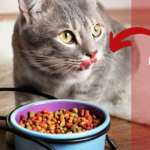
Whether or not Does Cat Food Attract Roaches is a common concern for cat owners. In contrast, all pet foods have the potential to draw Roaches. Research shows that cat food may be particularly appealing due to its high protein and fat. Roaches are a common pest issue for many homeowners with pets. A study published by the Journal of Economic Entomology in 2017 found that-
Up to 80% of roach infestations were linked to the presence of pet food.
Researchers studied 300 homes with roach problems. He found cat food attractive to Roaches because it has lots of protein and oil.
They suggest keeping cat treats in sealed containers and cleaning up right after pets eat to reduce the risk of attracting Roaches.
Although all pet food can attract Roaches- The study shows that cat food is especially appealing because it has a lot of nutrients.
Journal of Economic researcher find-
Scientists tested different roach attractants like fruit oils, fish oil, peanut butter, and bacon. Traps with these attractants caught more Roaches than traps without attractants. Apple and blueberry oil together caught over 100% more Roaches.
A roach tablet also caught over 100% more Roaches. Bacon caught 92% more Roaches. Apple and blueberry oil together worked best. Even an old oil mixture at least 2 weeks old and fresh oil for catching Roaches worked.
6 Foods That Attract Roaches
CockRoaches aren’t generally poisonous, explains Dr. Mike Richards, a Virginia-based veterinarian. [https://qr.ae/pyPl3r]
CockRoaches, those persistent insects capable of adapting to various environments. They are particularly attracted to certain types of foods. Knowing what foods Roaches like is essential to keep them out of your home. We’ve identified seven foods that cockRoaches find irresistible. We’ll share tips on how to prevent them from infesting your home.
Sugar:
The sweetness of sugar acts as a magnet for Roaches. Spilled sugary beverages, uncovered desserts, or sticky residues can beckon them. Stay vigilant by cleaning up spills and storing sugary treats in sealed containers to cut their appeal to Roaches.
Starch:
Foods rich in starch, such as bread, cereals, and pasta, make Roaches salivate. To limit the access of cockRoaches to your food, organize your pantry well in an airtight box.
Meat:
Roaches are not fussy eaters when it comes to meat. Leftovers, unwashed dishes, and even pet food can lure them in. Prevent their interest by cleaning food residue, washing dishes and storing pet food in a sealed box.
Cheese:
The potent aroma of cheese acts as a siren call for Roaches. Ensure cheese is stored and clean up any spills or crumbs to reduce their appeal.
Garbage:
The pungent scent of decaying food in garbage cans becomes an irresistible feast for Roaches. To discourage the presence of cockRoaches, keep the surrounding area clean and seal your garbage cans. It will help cut down on their attraction to your home.
Grease:
Greasy residues from cooking provide Roaches with a feast fit for royalty. Counter their interest by cleaning up spills and wiping down stoves
N.B: To prevent a roach infestation. Maintaining a clean and hygienic environment along with regular pests is crucial.
To deter Roaches from your home, denying them access to tempting food sources is important. You are keeping your home clean and free of clutter, fixing leaks and moisture issues. Its sealing cracks and crevices can all help reduce the chances of a roach infestation.
Are Roaches Attracted To Cat Litter?
Cat litter boxes can be popular for Roaches because they offer food, water, and shelter. The moist environment and leftover cat food particles surrounding the litter box can attract Roaches.
Key reasons Roaches are drawn to cat litter boxes:
• Food particles:
Bits of dry and wet cat food that fall into the litter or around the box provide Roaches with a ready food source.
• Moisture:
Moistened litter and areas where cats have urinated offer Roaches needed water, especially during dry seasons.
• Protein:
Stray cat hair, skin and dried faeces in the litter box supply roach with protein and nutrients.
• Shelter:
The warmth and shelter of the litter box offer Roaches an ideal place to live and reproduce. Litter also provides nesting materials.
How To Safe Cats From Roaches
Roaches can be hazardous pests for cats, bacteria and parasites that cause illness. There are proactive steps owners can take to safeguard their cat companions from Roaches.
Start by removing food sources and hiding places for Roaches in areas cats frequent. Store pet food in tight containers, clean food and water bowls daily, and wipe up food spills and debris. clean litter boxes every day and look for cracked or crumbling concrete that Roaches may shelter within.
Seal any holes larger than 1/8 inch around windows, doors, baseboards and pipes with caulk. Install door sweeps and weather stripping on all entryways. Use fans and dehumidifiers to maintain moderate humidity levels around 35-50%, as Roaches thrive in damp places.
You can spray insecticides along the baseboards, under appliances, and behind furniture in areas where cats cannot go.
Opt for boric acid powder,
Diatomaceous earth or finely-ground silica gel to control Roaches in basements and attics cats cannot reach. Reapply treatments every 4-6 weeks and store chemicals in locked cabinets away from pets.
Regularly groom your cat to remove roach eggs attached to its fur. Bathe the cat using a flea and tick shampoo safe for their age and health status.
Exclusion efforts and targeted treatments can help you keep Roaches at bay and protect your furry feline friend.
Can Cockroaches Be Harmful To Cats?
Cockroaches can be harmful to cats in several ways:
Disease Transmission:
Roaches can carry bacteria, viruses, and parasites that cause cat diseases. They walk through contaminated waste and dust and then come in contact with food and surfaces the cat encounters. This can spread illness to the cat.
Allergens:
Roach droppings, body parts, and shed exoskeletons can cause allergic reactions or asthma in sensitive cats. The allergens become airborne and the cat inhales them, triggering symptoms.
Bites:
Some roach species are known to bite cats, especially if the Roaches feel threatened. The bites themselves can cause inflammation, itchiness, and pain.
Ingestion:
If a cat catches and eats Roaches, especially large numbers. It could cause gastrointestinal upset like vomiting and diarrhea. The Roaches may also contain pesticides or other toxins that can sicken the cat.
Parasites:
Certain species of Roaches can carry parasites that infect cats. When they come in contact or the cat inadvertently ingests the parasites from roach droppings. The parasites can cause conditions like mange, tapeworms, and roundworms in cats.
Lethargy And Weight Loss:
A severe roach infestation can lead to a cat becoming stressed, irritated, and unable to sleep well. Over time, this can result in lethargy, decreased appetite, and weight loss in the cat.
Conclusion
In conclusion, Many types of cat food have high protein, fat, and moisture content, which make them attractive to Roaches. Roaches can get the amino and fatty acids they need from the meat, fish, and animal byproducts of cat food. Wet cat food and dirty litter boxes can also provide Roaches with the moisture and food particles they need. But you can help reduce the risk of attracting Roaches by handling and storing cat food and cleaning litter boxes daily. If you already have a roach infestation due to cat food or litter boxes. You may need to improve sanitation and use targeted pest control treatments. By keeping things clean and managing pests, cat owners can lower the risk of roach infestations.
Patricia White is a pet enthusiast. With 10 years of experience in the pet industry, she brings a wealth of knowledge and expertise to MeToPet. She is honored to be a part of the MTP team and is dedicated to sharing her passion for pets with our readers.









